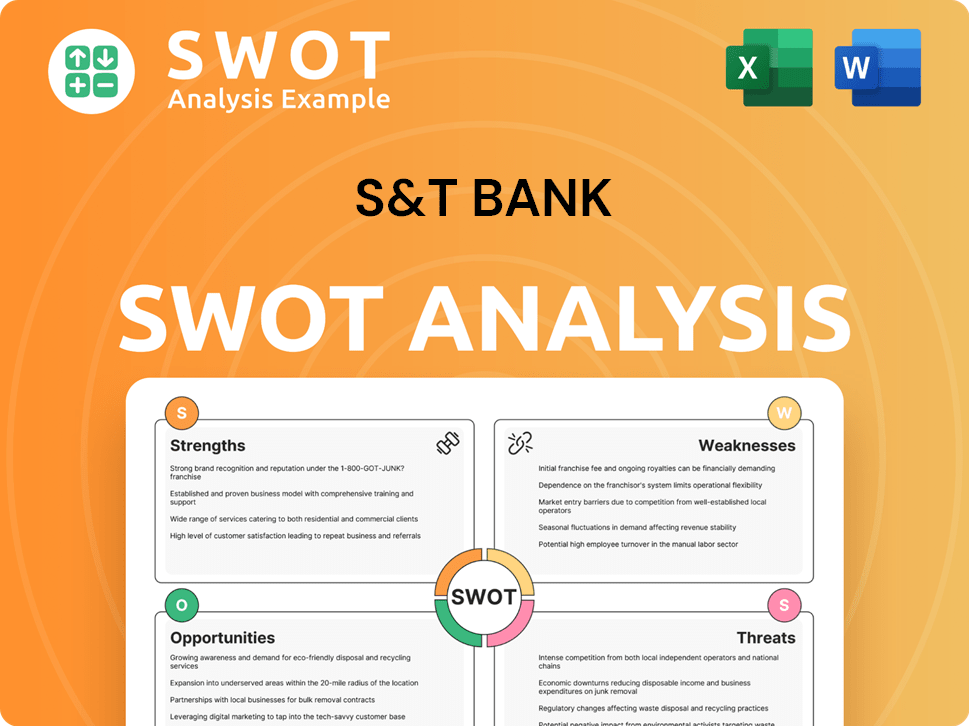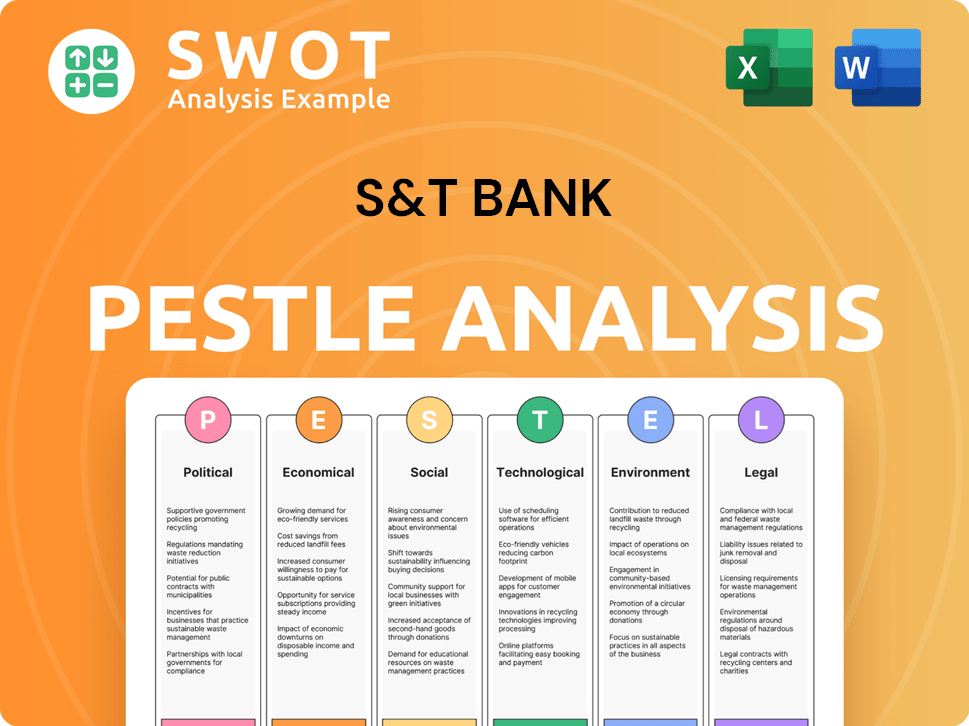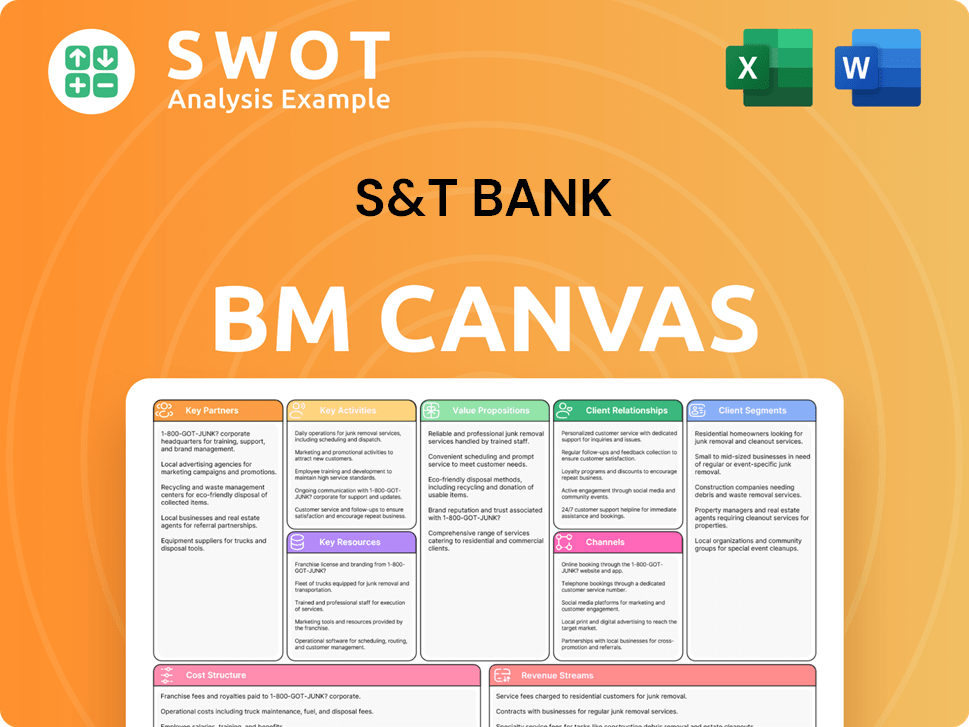S&T Bank Bundle
Who Really Controls S&T Bank?
Understanding a company's ownership is crucial for investors and strategists alike. The ownership structure of S&T Bank, a financial institution with deep roots, reveals key insights into its strategic direction and market positioning. This article explores the evolution of S&T Bank's ownership, from its inception to its current status as a publicly traded company.

Delving into the ownership of S&T Bank, we uncover the influence of its S&T Bank SWOT Analysis on its strategic decisions. Knowing who the S&T Bank shareholders are and the S&T Bank parent company provides a clearer picture of the bank's priorities and future prospects. This analysis goes beyond just identifying the major stakeholders; it examines how the S&T Bank ownership structure has shaped its governance and financial performance, including the roles of S&T Bank executives and the board of directors.
Who Founded S&T Bank?
The story of S&T Bank began on May 19, 1902, under the name 'The Savings & Trust Company of Indiana'. The bank was officially incorporated two days later, marking the start of its journey in the financial sector. John A. Scott was appointed as the first president, setting the tone for the institution's early operations.
While the exact initial ownership structure and equity splits among the founders are not detailed in the provided information, the bank's early focus was on serving the local community. This commitment to local service and a conservative approach to banking were key principles from the start. This focus helped the bank gain trust and establish a solid foundation.
The bank's initial operations were centered in Indiana, Pennsylvania, operating from a single location. Ephraim Enzer Lewis, who became manager in 1913, played a vital role in steering the bank through difficult times, including the Great Depression. His leadership ensured the bank's stability and recovery during this period. By 1940, the bank's assets had grown to over $6.0 million, demonstrating its early success and the trust it had earned within the community.
In 1983, S&T Bancorp, Inc. was organized and incorporated, signaling a shift towards a holding company model. This change allowed for greater flexibility and strategic growth. The Marketing Strategy of S&T Bank has evolved over the years to reflect these changes and adapt to market demands. The bank's history shows a consistent commitment to community banking while adapting to the changing financial landscape.
- The bank's early focus was on serving the local community.
- Ephraim Enzer Lewis's leadership was crucial during the Great Depression.
- By 1940, assets had grown to over $6.0 million.
- 1983 marked the incorporation of S&T Bancorp, Inc.
S&T Bank SWOT Analysis
- Complete SWOT Breakdown
- Fully Customizable
- Editable in Excel & Word
- Professional Formatting
- Investor-Ready Format

How Has S&T Bank’s Ownership Changed Over Time?
The evolution of S&T Bancorp, Inc.'s ownership structure has been significantly shaped by its transition to a publicly traded company. Initially listed on the NASDAQ in 1992, the company has since seen its ownership predominantly held by institutional investors. As of May 29, 2025, the market capitalization stood at approximately $1.42 billion, with roughly 38.3 million shares outstanding. The ownership structure reflects a strong institutional presence, with institutional investors holding 69.51% of the shares and mutual funds holding 57.68% as of May 2025.
Strategic acquisitions have also played a crucial role in shaping the company's footprint and, consequently, its ownership dynamics. Key acquisitions include Integrity Bank in March 2015, Mainline National Bank, and Gateway Bank. These moves contributed to S&T Bank's expansion across Pennsylvania and into Ohio and New York. The company's history and growth trajectory, including its financial performance, are key factors for those interested in understanding the competitive landscape of S&T Bank.
| Shareholder | Shares Held (as of March 31, 2025) | Percentage of Ownership |
|---|---|---|
| Blackrock, Inc. | 5,585,719 | N/A |
| Vanguard Group Inc. | 4,578,175 | N/A |
| Dimensional Fund Advisors LP | 2,387,500 | N/A |
As of March 31, 2025, major institutional shareholders include Blackrock, Inc., Vanguard Group Inc., and Dimensional Fund Advisors LP. Insider ownership, including directors and executive officers, held approximately 1.38% of the outstanding common stock as of February 28, 2024. This figure has slightly increased to 0.93% as of May 2025. These details offer insights into who owns S&T Bank and the distribution of its shares among various stakeholders, including S&T Bank shareholders and S&T Bank executives.
S&T Bancorp, Inc. is a publicly traded company with a market capitalization of $1.42 billion as of May 29, 2025.
- Institutional investors hold 69.51% of the shares.
- Mutual funds hold 57.68% of the shares.
- Insider ownership was approximately 1.38% as of February 28, 2024, increasing to 0.93% in May 2025.
- Major shareholders include Blackrock, Inc., Vanguard Group Inc., and Dimensional Fund Advisors LP.
S&T Bank PESTLE Analysis
- Covers All 6 PESTLE Categories
- No Research Needed – Save Hours of Work
- Built by Experts, Trusted by Consultants
- Instant Download, Ready to Use
- 100% Editable, Fully Customizable

Who Sits on S&T Bank’s Board?
As of March 31, 2025, the Board of Directors of S&T Bancorp, Inc. has 11 members, a number determined by the Board's resolution for 2025. These directors are elected annually, each serving a one-year term that concludes at the subsequent annual shareholder meeting. The Board's main responsibility is to oversee the business operations and affairs of S&T Bank and its officers, always acting in the best interests of the company and its shareholders. The current leadership includes Christine J. Toretti as Chair of both the S&T Board and the S&T Bank Board.
The Board includes individuals with diverse expertise, spanning legal, financial, and business backgrounds. Key figures include Lewis W. Adkins Jr., Peter R. Barsz, Christina A. Cassotis, Michael J. Donnelly, Jeffrey D. Grube, William J. Hieb, and Bhaskar Ramachandran, who joined in 2024. Christopher J. McComish serves as the Chief Executive Officer and a Director, and David G. Antolik is the President and a Director. Frank J. Palermo, Jr. retired from the board on May 13, 2025, after 12 years of service, due to mandatory retirement age.
| Director | Title | Key Role |
|---|---|---|
| Christine J. Toretti | Chair | Oversees the S&T Board and S&T Bank Board |
| Christopher J. McComish | Chief Executive Officer & Director | Leads the company's operations |
| David G. Antolik | President & Director | Manages the company's strategic initiatives |
| Lewis W. Adkins Jr. | Director | Provides financial expertise |
| Peter R. Barsz | Director | Contributes to strategic planning |
| Christina A. Cassotis | Director | Brings business acumen |
| Michael J. Donnelly | Director | Offers legal and financial insights |
| Jeffrey D. Grube | Director | Offers financial insights |
| William J. Hieb | Director | Provides corporate governance expertise |
| Bhaskar Ramachandran | Director | Brings additional expertise |
| Frank J. Palermo, Jr. | Former Director | Retired May 13, 2025 |
The voting structure for S&T Bancorp's common stock is straightforward: one share equals one vote, with no cumulative voting rights. As of February 28, 2025, there were 38,370,213 shares of S&T Bancorp common stock issued and outstanding. While individual beneficial ownership by directors and executive officers is typically less than 1% of outstanding shares, the group collectively held approximately 1.38% as of February 28, 2024. Understanding the S&T Bank ownership structure is key for investors. For more insights, consider reading about the Growth Strategy of S&T Bank.
S&T Bank is a publicly traded company, and its ownership is spread among various shareholders. The board of directors plays a crucial role in the company's strategic decisions.
- Board of Directors: Oversees company operations.
- Voting Rights: One share, one vote.
- Shareholder Base: Includes institutional and individual investors.
- Executive Ownership: Executives and directors hold a portion of the shares.
S&T Bank Business Model Canvas
- Complete 9-Block Business Model Canvas
- Effortlessly Communicate Your Business Strategy
- Investor-Ready BMC Format
- 100% Editable and Customizable
- Clear and Structured Layout

What Recent Changes Have Shaped S&T Bank’s Ownership Landscape?
Over the past few years, S&T Bancorp has shown consistent financial performance. In 2024, the company reported a net income of $131.3 million, with earnings per diluted share (EPS) of $3.41. Key financial metrics for 2024 included a return on average assets (ROA) of 1.37%, a return on average equity (ROE) of 9.86%, and a return on average tangible equity (ROTE) of 13.84%. Total assets remained stable at $9.7 billion as of March 31, 2025, and December 31, 2024.
Recent trends in S&T Bank ownership reveal a relatively stable institutional holding, accounting for approximately 69.51% in May 2025. Insider holdings saw a slight increase from 0.91% to 0.93% during the same period. The company's commitment to shareholder returns is evident through consistent dividend declarations, such as the $0.34 per share cash dividend approved on January 29, 2025. Understanding the Target Market of S&T Bank is crucial for evaluating its long-term strategy.
Leadership changes and industry recognition also mark recent developments. Melanie A. Lazzari was appointed Executive Vice President, Chief Accounting Officer, effective May 13, 2025. S&T Bancorp was recognized as one of Forbes' 2024 America's Best Banks and included in Bank Director's 2024 RankingBanking list. Furthermore, the company continues to focus on growth, with total portfolio loans increasing by $93.4 million, or 4.89% annualized, compared to December 31, 2024.
S&T Bank is a publicly traded company, and its ownership is primarily composed of institutional investors and individual shareholders. The ownership structure is subject to change based on market dynamics and investor behavior. Understanding who owns S&T Bank is key.
Institutional investors hold the majority of shares in S&T Bank. The exact percentages and specific institutional holders can fluctuate. Insider ownership, including shares held by executives and board members, is also a factor in the ownership profile of S&T Bank.
The leadership team at S&T Bank plays a crucial role in the company's strategic direction. Key personnel include the CEO, CFO, and other executive officers. Changes in leadership can impact the company's performance and shareholder value.
S&T Bank's financial performance, including metrics like ROA, ROE, and EPS, is critical for investors. Dividend payouts and stock price movements reflect the company's commitment to returning value to shareholders. S&T Bank's stock price is influenced by market conditions.
S&T Bank Porter's Five Forces Analysis
- Covers All 5 Competitive Forces in Detail
- Structured for Consultants, Students, and Founders
- 100% Editable in Microsoft Word & Excel
- Instant Digital Download – Use Immediately
- Compatible with Mac & PC – Fully Unlocked

Related Blogs
- What are Mission Vision & Core Values of S&T Bank Company?
- What is Competitive Landscape of S&T Bank Company?
- What is Growth Strategy and Future Prospects of S&T Bank Company?
- How Does S&T Bank Company Work?
- What is Sales and Marketing Strategy of S&T Bank Company?
- What is Brief History of S&T Bank Company?
- What is Customer Demographics and Target Market of S&T Bank Company?
Disclaimer
All information, articles, and product details provided on this website are for general informational and educational purposes only. We do not claim any ownership over, nor do we intend to infringe upon, any trademarks, copyrights, logos, brand names, or other intellectual property mentioned or depicted on this site. Such intellectual property remains the property of its respective owners, and any references here are made solely for identification or informational purposes, without implying any affiliation, endorsement, or partnership.
We make no representations or warranties, express or implied, regarding the accuracy, completeness, or suitability of any content or products presented. Nothing on this website should be construed as legal, tax, investment, financial, medical, or other professional advice. In addition, no part of this site—including articles or product references—constitutes a solicitation, recommendation, endorsement, advertisement, or offer to buy or sell any securities, franchises, or other financial instruments, particularly in jurisdictions where such activity would be unlawful.
All content is of a general nature and may not address the specific circumstances of any individual or entity. It is not a substitute for professional advice or services. Any actions you take based on the information provided here are strictly at your own risk. You accept full responsibility for any decisions or outcomes arising from your use of this website and agree to release us from any liability in connection with your use of, or reliance upon, the content or products found herein.